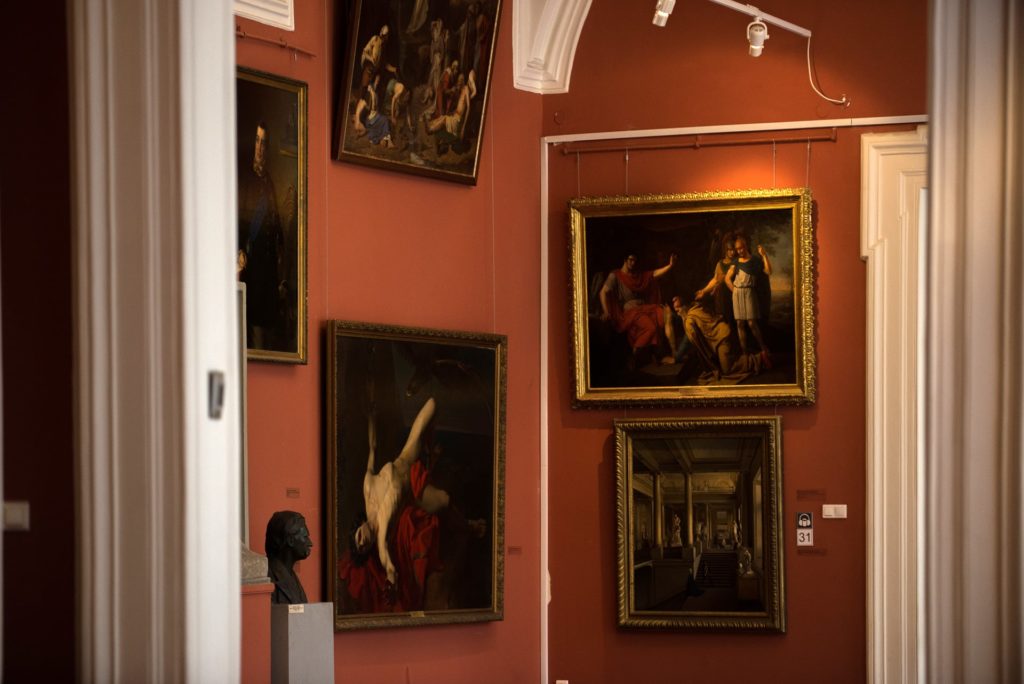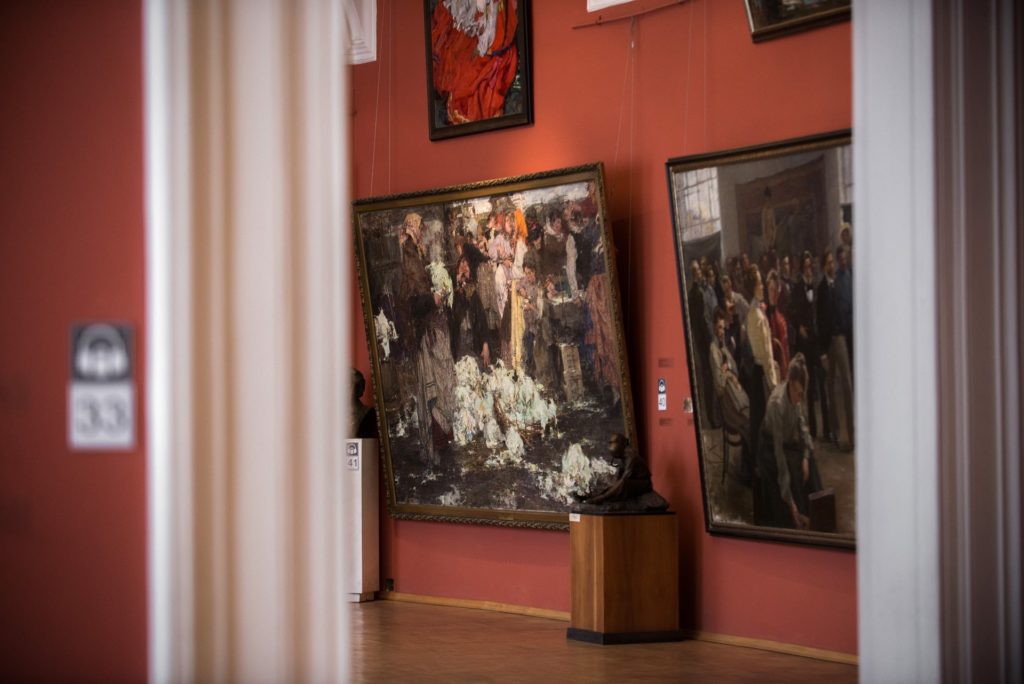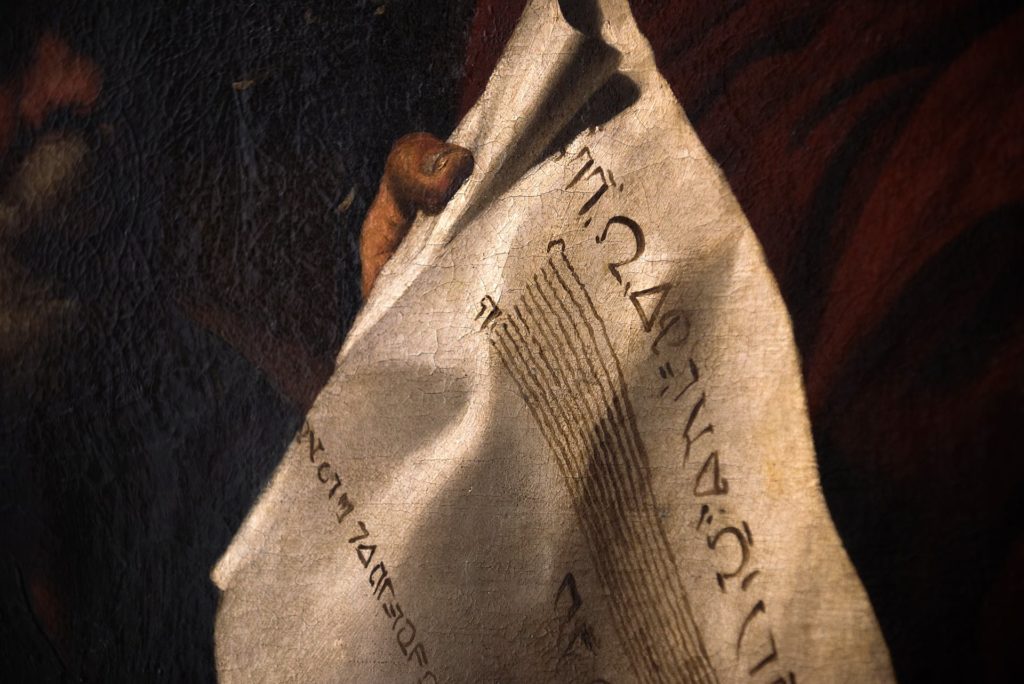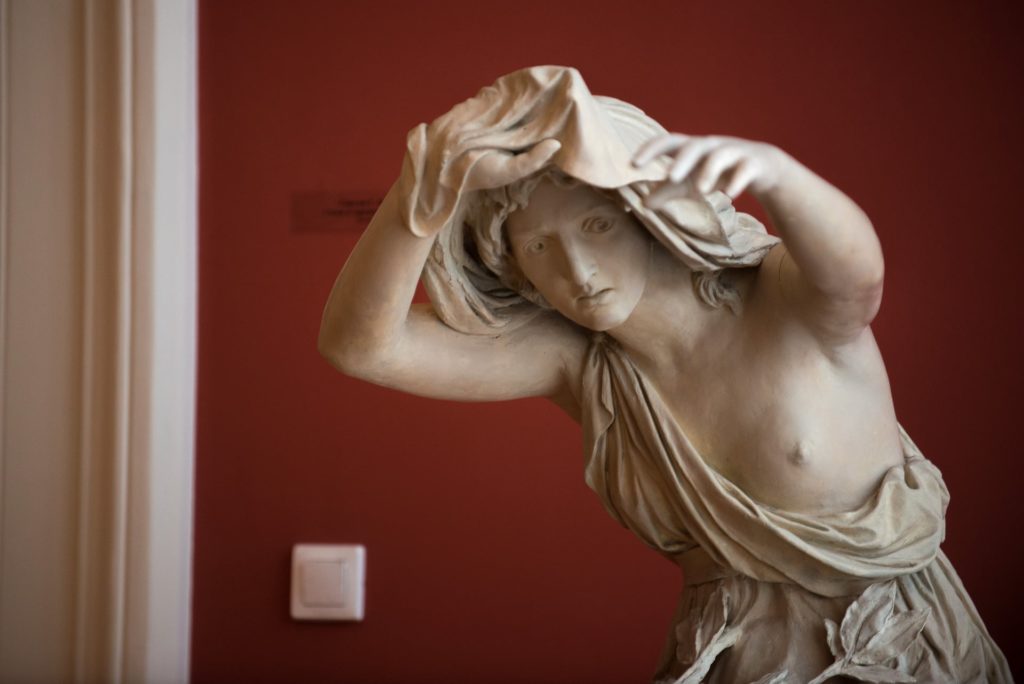Academic Museum
The permanent exhibition Academic Museum on the second floor, displays paintings from the museum's historical collection, the works of those famous artists, whose canvases were studied and copied by many generations of Russian students. This concept follows the principle behind the arrangement of the permanent exibition of the Museum of the Imperial Academy of Arts until 1917: in the halls “along the circular” on the second floor, where the Picture Gallery and sculptures were located, along with the best “course” paintings of Russian painters (works on given subjects, for which the authors received gold medals, artist, academician or professor title) works by foreign masters were also represented.
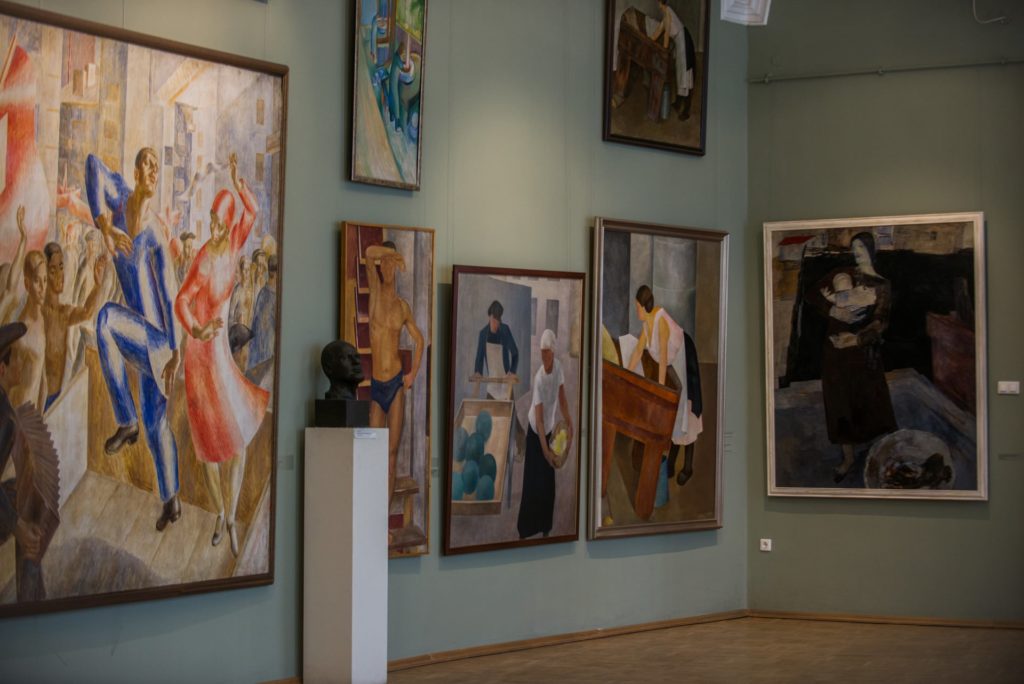
Todays exhibition on the second floor begins with works related to the early years of the Academy of Three Noble Arts. The earliest surviving portrait, titled Artist of Architecture, Drawing Plans and Facades (1807) was recieved by the museum as a supposed portrait of the architect Jean-Baptiste Vallin de la Mothe. The French architect was invited from France by I. Shuvalov. In St Petersburg he designed the building of the Academy of Arts and also adorned the young capital with a number of other buildings. The picture of V. Jacobi The Inauguration of the Academy of Arts on 7 July 1765 displays a different epoch. In 1763, Catherine II succeeded to the Russian throne. It was during her reign that the Academy of Arts, previously a department of the Moscow University, acquired its own Charter, staff and privileges. This took place on 4 November 1764. The same year the construction of the Academy building in stone began. It lasted through 1788 with interruptions. The opening ceremony was held in the old wooden building. In 1763 the curator of the Academy I.I. Shuvalov had to leave the court and go abroad but his ideas on the organization of the Academy formed the basis of the regulations drawn up by the new president I. Betskoy. The practice of admitting noble and wealthy people to the academic class which had been introduced by Shuvalov went on. According to a tradition, each Honorary Amateur or Honorary Member sent his portrait for the Council Hall. This was the case of the portrait of Count Pyotr Sheremetev, done by his serf artist I. Argunov. The general-in-chief and Moscow provincial marshal of the nobility, Count Sheremetev, following the fashion introduced in Russia by Catherine the Great, had an art collection and was elected Honorary Amateur in 1766. Among the images from the Council Hall of interest are the portraits of Prince Alexander Golitsyn by A. Varneck, Catherine II's minion Platon Zubov by I. Lampi the Elder, and the portrait of Baron P. Maltits, diplomat, elected Honorary Member and Director of the Academy, by an unknown 18th-century artist.
The first copies made by Russian artists abroad were Justice by A. Losenko from a fragment of the Stanza from the Room of Constantin in the Vatican Palace and The Abduction of Europa by G. Ugryumov. Both painters improved their skill in Italy, attended classes at the academies of fine arts, took lessons from famous teachers and sent copies to report their progress. A notable fact is that in the first case they chose to copy works of the Raphael school and in the second case they picked works of Veronese school. Catherine II paid a great deal of attention to the Academy and frequently came to the examinations and exhibitions, accompanied by her retinue. Thanks to the Empress a fine collection of works of art in the Hermitage was gathered. Many of the paintings bought abroad on her orders later entered the collection of the Academy. By the order of Catherine the Great, the Portrait of Empress Maria Theresia of Austria by Johann Peter Kobler — a gift to the Russian Empress Elizabeth Petrovna, who was an ally in the Seven Years' War, — was handed over to the Academy. One more ceremonial portrait attracts attention: portrait of Count V. Fermor, a participant of the Seven Years' War. Painted by A. Antropov in 1765, it gives an image of a military man and statesman, who was at the head of the Chancellery of Buildings since 1742. He was the beneficiary of Rastrelli's plans for the construction of the Smolny Convent ensemble, the wooden design model of which can be seen in the exhibiton of the Architecture Collection on the third floor. The Count is depicted in the uniform of a Knight of the Order of St. Andrew.
The Academy was the source of pride and honorable foreign guests often came to visit it. In 1774 João Carlos de Bragança, Duke of Lafões, the Portuguese Crown Prince, visited St Petersburg. He was accepted to the Academy as an Honorary Amateur of the arts. Later, upon his return to his native country, the prince founded the Academy of Arts and Sciences and became its first Headmaster. In 1780 the Prussian Prince Frederick William, who became king eight years later, was introduced to the Academy. A place of honor in the hall with the work Perseus and Andromeda by the German Classicism theorist A. Mengs is occupied by the portrait of Cardinal Alessandro Albani — a renowned art connoisseur who assembled a collection of antique works in his palace. At the request of I. Shuvalov, the Cardinal rendered assistance to many Russian artists whom the Academy sent to Rome for further studies.
The Massacre of the Innocents by the Venetian artist Andrea Celesti is the only surviving painting from Shuvalov's collection, which he had given to the Academy in 1758. Among the works from the early years of the Academy's collection there were four paintings, two of which are represented in the exhibition. In 1765 by imperial order, Luca Giordano's The Toilet of Bathsheba and a small canvas by Jean-Antoine Watteau, Fête in a Park, were brought from Oranienbaum (the authorship of the latter was not confirmed). In the early 19th century, old catalogs mention a painting Minerva Beats the Giants by Luca Giordano – a very typical work of the Neapolitan master who was taught by A. Giordano and J. Ribera. It is known that once it decorated the ceiling in the hall of Russian sculpture.
The gems of the collection are the two large-scale canvases Ulysses Discovering Achilles and Servius Tullius When a Child, Asleep by the famous Angelica Kauffmann. She was closely acquainted with Winkelmann and followed his principles, and was friends with Goethe. She was a court painter at the Royal Court of Naples and lived an interesting life rich on events. Both canvases were painted in Rome on the order of Catherine II and are typical for the mature period of the master’s work. The Russian Empress was also the reason why works from the collection of Lord R. Walpole from the English castle Houghton Hall appeared in St. Petersburg. Pier Francesco Mola's paintings Marcus Curtius Plunging into the Abyss and Horace Cockles defending the Sublician Bridge are based on the History of Rome by Titus Livius, as well as the painting Sophonisba Taking Poison by the Venetian painter Gregorio Lazzarini. Some time earlier there was another Lazzarini's work in the collection of the Academy.
In 1863 Count N. Kushelev-Besborodko bequeathed to the Imperial Academy of Arts a vast collection of paintings and sculptures. In addition to paintings by “old masters” which he inherited from his ancestors, it included works by artists of the Barbizon school, purchased by Kushelev-Besborodko in France. This part of the collection, described by I. Repin, V. Perov, M. Nesterov, K. Korovin and A. Benois, was most important for the Russian painters who studied the secrets of open-air painting at the Kushelev Gallery. The updated exhibition shows the few canvases left in the Museum. These are F. Carracci's The Incredulity of Saint Thomas (a copy of a canvas by Guercino), A Battlefield by Georg Philipp Rugendas, a still-life by Daniel Seghers, a beautiful female portrait by an unknown 17th-century Dutch artist, and Crucifixion by an unknown 17th-century Italian master. In 1918 a large and most valuable part of this collection was handed to the Hermitage Museum.
One of the pearls of the museum's collection is a 17th-century painting Lot and His Daughters by Dutch painter Reyer van Blommendael. It is the world's third famous signed work by the artist from Haarlem.
The next three halls show the best works of Russian painters of the 18th — early 20th centuries: training works by A. Ivanov, I. Repin, A. Savinov and I. Myasoedov; graduation paintings by V. Polenov and N. Feshin; works of the mature period of K. Bryullov, I. Shishkin, A. Arkhipov and other distinguished painters. All these canvases demonstrate the progress of the art school. Among them are works for which the authors were awarded the titles of an artist, academician or professor.
The gems of the collection are The Resurrection of Jairus' Daughter by V. Polenov (1871) and The Cabbage Girl by N. Feshin (1909). The painting Staging of Nature in the Studio of Ilya Repin at the Academy of Arts is also unique. It was painted by pupils of I. Repin between 1899 and 1903. The painting was done from a sketch by B. Kustodiev by students of the Higher Art School at the Imperial Academy of Arts. Among the depicted characters are I. Repin, F. Malyavin, A. Murashko, I. Kulikov, I. Bilibin, and A. Ostroumova, who determined the future of Russian art.
In April 1918 the Imperial Academy of Arts was no longer a state institution. Instead of the Higher Art School, the Free Art School was opened. Same year in August the Petrograd State Free Art and Training Workshops (PGSKhUM) were opened. Artists of both art directions taught there: A. Rylov, A. Savinov, A. Matveev, L. Sherwood from the “right” and A. Andreev, N. Altman, M. Matyushin, V. Tatlin from the “left”. The latter supported the search for new forms in art. In 1921 the workshops were renamed the Academy of Arts, and received approved Charter and curriculum. In 1922 the Academy of Arts and the former Technical Drawing School of Baron A. Stieglitz merged. The new educational institution was named the Petrograd Higher Art School (VKhUTEMAS). Apart from Rector V. Simonov, the Board included K. Petrov-Vodkin, S. Serafimov, V. Denisov, and A. Karev.
This was not the last time the institution was renamed as the ideologies struggled. The short period between 1925 and 1929 when the artistic heritage of the past was once again studied on the initiative of Rector E. Essen, resulted in the victory of the Proletkult. The new director, F. Maslov, became the Rector of the Leningrad Higher Institute of Art and Technology, which was the new title of the Academy. In accordance with the orders, F. Maslov began to restructure the Institute to introduce industrial and technical education.
In 1930 the Moscow and Leningrad Higher Art and Technical Institutes (VKhUTEINs) were reorganized again. The Department of Painting and the Department of Sculpture were transferred from Moscow to Leningrad, and the Department of Printing was transferred from Leningrad to Moscow. Maslov became the Director of the new merged Institute of Proletarian Fine Arts. One of his main goals was to attract students from proletariat. The Institute had daytime and evening worker's faculties (rabfaks) with departments of painting and sculpture. The young workers who finished the program were admitted to the institute without entrance exams.
In July 1931 the new structure of the Institute was approved, and its faculties were reorganized according to the industry-specific principle. The following specializations were introduced: painting and sculpture for practical use, polytechnic amateur painting (artistic and pedagogic or club and instructor specializations were available), entertainment arts (theater, cinema, public performance design), etc. When prominent artists and art historians, who stood against the changes, heard about several museum exhibits being destroyed, expressed their concern by speaking through the press.
In the summer of 1932 Maslov was sacked from his position. The same year the institute was renamed Leningrad Institute of Painting, Architecture, and Sculpture, and the sculptor A. Matveev was appointed as its Director. On 11 October 1932, a decree `On the creation of the Academy of Arts` was signed. Since 1934 the All-Russian Academy of Arts in Leningrad was headed by I. Brodsky.
In the eighth hall of the permanent exhibition study and diploma works from the 1920s-1930s are for the first time represented at such a large scale. Most of the paintings at the exhibition are by unknown artists on industrial topics. The best representation has the workshop of K. Petrov-Vodkin, who supervised the education of E. Evenbakh, N. Sekirin, E. Aladzhalova, and E. Blagoveshchenskaya. Many students admired teaching skills of A. Karev. It is interesting to compare the graduation projects of his students S. Vasilevskaya-Pecheneva and A. Pochtenny on the topic “Washerwoman” (1926).
The work Woman with Child (1925) by E. Gaskevich, which was the author's graduation project, is displayed for the first time after restoration. The author was a student of A. Eberling, and later joined the famous Circle of Artists (1926—1932).
The period of quests and experiments ended in the early 1930s. The Resolution of the Central Committee of the CPSU (b) “On the restructuring of literary and artistic organizations” (1932), and the proclamation of the “socialist realism” as the main style, determined the path of development of Soviet art for many decades.
However, the next period in the history of Russian art school was not devoid of creative disputes either. This can be seen on the example of the works of the A. Savinov’s and A. Osmerkin’s students – On the Farm (1931—1935) and Behind the Curtain. Nude by G. Pavlovsky, Milking Sheep in a Nomad Camp (1937) by E. Aslamazyan, – who were enthusiastic about the search of colour. Their diploma projects, painted in the workshop of I. Brodsky (Hero of the Soviet Union N. Yudin, Visiting Komsomol Members – Tank Crew, Who Are Issuing a Bulletin-Board Newspaper (1938) by A. Laktionov, and Professor I. Brodsky in His Workshop with His Students by A. Zarubin), with their typical prevalence of drawing, give a different perspective on the development of the artistic school. Students of the V. Yakovlev’s workshop kept the traditions of the realistic painting manner of Peredvizhniki (B. Scherbakov Chaser, 1935).
A later painting The First Workers' School (1959) by L. Krivitsky reflects the atmosphere of the turn of 1920—1930's, when illiterate proletarian youth reached for knowledge.
Ayant by M. Manizer is the earliest sculpture made in 1918. The 1920s period is represented by The Harvester (1926) – the graduation work of V. Beloshapko, and the model of a head for the monument to the Commissar for the Press, Propaganda and Agitation V. Volodarsky designed by L. Bleze-Manizer. The monument by M. Manizer and L. Bleze-Manizer was opened in 1925. The Sculpture section includes works of the 1920—1930s by the students of M. Manizer and A. Matveev. It is also worth to mention the portrait bust of the architect A. Nikolsky, a well-known constructivism master, made by M. Murizier in 1933.
The exhibition is complemented by photographs of the Academy of those years — teachers, students, training workshops, the museum halls and the church, turned into a gym.
